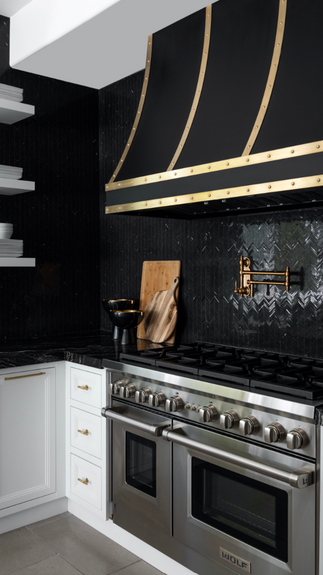The Impact of Grout Color
- Coley Snyder
- Apr 4, 2024
- 4 min read
Grout color can significantly impact the overall aesthetic of tile installations and influence the perception of the design. Here are some ways grout color can make a difference in tile design:
Contrast or Blend: Grout color can be chosen to either contrast with or blend seamlessly with the tiles. A contrasting grout color can highlight the individual tiles, creating a bold and dynamic look, while a matching or complementary grout color can create a more cohesive and uniform appearance, allowing the tiles to blend together visually.
Emphasis and Accentuation: By selecting a grout color that contrasts with the tiles, certain patterns or shapes within the design can be emphasized or accentuated. For example, using a darker grout color with light-colored tiles can outline each tile and enhance the geometric or mosaic pattern, drawing attention to the intricate details of the design.
Visual Perception of Space: The choice of grout color can affect how spacious a room appears. Light-colored grout tends to create a sense of openness and airiness, as it visually expands the space between tiles, while dark-colored grout can make the individual tiles stand out more, resulting in a cozier or more intimate atmosphere.
Style and Mood: Grout color can contribute to the overall style and mood of a space. For example, using white or light-colored grout with subway tiles can evoke a classic and timeless look, reminiscent of traditional subway stations. On the other hand, pairing dark-colored grout with modern, large-format tiles can lend a contemporary and edgy vibe to the design.
Maintenance and Longevity: The color of grout can also impact the maintenance and longevity of tile installations. Light-colored grout tends to show less dirt and discoloration over time compared to darker grout, which may require more frequent cleaning to maintain its appearance. Additionally, choosing a grout color that closely matches the tiles can help disguise any imperfections or staining that may occur over time.
As we explore the nuances of grout color, it's important to note how its effects vary between large-format tiles and mosaics. While large-format tiles benefit from grout color choices that emphasize pattern or contribute to a sleek aesthetic, mosaics offer a canvas for intricate detail and personalized expression through grout selection. Let's delve deeper into how grout color influences these two tile types.
Large Format Tiles:
Enhanced Uniformity: Large-format tiles typically have fewer grout lines compared to smaller tiles, creating a more continuous surface. Light-colored grout used with large-format tiles can contribute to a seamless and expansive appearance, as it minimizes the contrast between tiles and visually enlarges the space.
Emphasis on Tile Pattern: When paired with a contrasting grout color, large-format tiles can highlight the tile pattern or layout. Darker grout can outline each tile, emphasizing the grid-like arrangement or specific patterns within the tiles. This approach can add visual interest and architectural detail to the overall design.
Clean and Modern Aesthetic: Light-colored grout with large-format tiles can evoke a clean and modern aesthetic, particularly in minimalist or contemporary spaces. The light grout helps create a sleek and streamlined look, allowing the focus to remain on the tiles themselves without distracting from their size or texture.
Maintenance Considerations: Light-colored grout used with large-format tiles may require more frequent cleaning to maintain its pristine appearance, as any dirt or discoloration can be more noticeable against the light background. However, proper sealing of the grout can help mitigate staining and simplify maintenance over time.
Mosaic Tiles:
Enhanced Detail and Texture: Mosaic tiles feature intricate patterns and textures, and the choice of grout color can significantly impact their visual impact. Contrasting grout colors can highlight the individual pieces of the mosaic, accentuating the texture and detail of the design. This approach creates a dynamic and visually stimulating surface.
Pattern Integration: Mosaics offer versatility in design, allowing for the creation of intricate patterns and motifs. The selection of grout color can either integrate or separate these patterns within the mosaic. Matching the grout color closely to the dominant color of the mosaic tiles can create a cohesive and harmonious look, while contrasting grout can delineate the individual elements of the pattern.
Personalized Expression: The choice of grout color with mosaic tiles offers an opportunity for personalized expression and creativity. Homeowners and designers can experiment with different grout colors to achieve unique effects, such as creating a monochromatic or multi-tonal mosaic, or adding a pop of color to the overall design scheme.
Maintenance and Durability: Due to the smaller size of mosaic tiles and the increased grout-to-tile ratio, proper sealing and maintenance of grout are essential to preserve the integrity of the installation. Dark-colored grout may be more forgiving in terms of staining and discoloration, as it can conceal dirt and wear more effectively than light-colored grout. However, both light and dark grout colors can be successfully used with mosaic tiles, depending on the desired aesthetic and maintenance considerations.
Overall, the selection of grout color should be considered as an integral part of the tile design process, as it can significantly influence the final look and feel of the space. By carefully choosing the right grout color, you can enhance the beauty and functionality of your tile installations while achieving the desired aesthetic effect.


















Comments